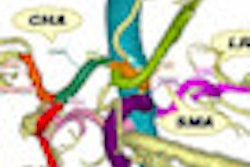Virtual colonoscopy is cost-effective for colorectal cancer screening, assuming that only patients with polyps 6 mm or larger are referred for polypectomy, a new French study has concluded. Removing the smallest lesions is not only prohibitively expensive, the yield in terms of additional colorectal cancer cases is minimal, the authors reported.
Beyond polyp size, the researchers found that what really affected the cost-effectiveness calculations were not the obvious input factors such as the accuracy of virtual colonoscopy (also known as CT colonography or CTC) or the level of community participation in screening, but rather the input values for disease prevalence, and the progression rate from polyp to colorectal cancer. As shown in previous papers, VC generally became more cost-effective as disease prevalence and the rate of progression grew.
The cost-effectiveness question has certainly been studied before in CTC, but many previous models assumed that patients with CTC-detected polyps, even tiny lesions 5 mm or smaller, would be referred to optical colonoscopy to have them removed, with the associated high costs of that screening model, noted Denis Heresbach, MD, PhD; Pauline Chauvin, MD; and colleagues from the University of Rennes and Centre National de la Recherche Scientifique in Rennes, France.
Complicating the calculation is that while the prevalence of neoplastic lesions has been determined in the general population, the frequency of advanced neoplasia according to polyp size has only been established in per-lesion analysis and not in consecutive studies, the authors noted.
Two cost-assessment strategies
"The aim of our model was to assess the yield of referring patients to colonoscopic polypectomy for all polyps or only for small and large CTC-detected polyps, respectively," Heresbach and his team wrote. "Although this approach was debated in a previous U.S. model, our original contributions rely on base-case analysis according to the sex of average-risk participants or range of advanced adenoma ... frequencies, and on the inclusion of the cost of follow-up colonoscopies according to current guidelines" (European Journal of Gastroenterology and Hepatology, August 26, 2010).
In the model, CTC was offered at ages 50, 60, and 70 years, up to age 80. The hypothetical cohort consisted of 100,000 mixed patients (49,052 men and 50,948 women), based on gender distribution in France.
The investigators modeled two CTC screening strategies, either with no polyp-size reporting threshold (PL strategy) or a 6-mm polyp-size reporting threshold (TS strategy), for referral to a subsequent polypectomy or neoplasia biopsy (Col-P).
Clinical efficacy was defined by the reduction in colorectal cancer (CRC) incidence as well as life years gained (LYG), compared with the no-screening strategy. The authors assessed the incremental cost-effectiveness ratio (ICER) for both PL and TS strategies based on the costs incurred for each additional life year compared with the natural history of the cohort (no-screening strategy).
They also calculated an efficiency ratio (ER) for the screening exams as a ratio between the relative number of life years gained and the relative number of colonoscopies, and modeled disease progression throughout the disease spectrum for common lesion types, including the possibility of additional lesions arising after the baseline exam.
"To comprehend both the screening stage and a comprehensive description of treatment and surveillance of CRC, we had to embed two Markov models, one for each stage," Heresbach and colleagues explained. Costs were based on a third-party payor perspective using French classification and data for healthcare rates.
Cost-effective at 6 mm
The results showed that CTC with a 6-mm threshold for polypectomy referral was associated with substantial cost reductions without significant loss of efficacy, compared with removing all detected polyps.
Using the PL strategy induced a drop in the total number of colorectal cancer cases from 4,531 to 2,813 (37.9%) versus no screening, with the TS strategy producing a drop nearly as large at 36.5%. The two strategies produced a reduction in colorectal cancer deaths of 47.2% and 46.5%, respectively, versus no screening.
But while the two strategies reduced cancer cases at similar rates (36.5% for TS and 37.9% for PL), the costs of following these strategies could hardly have been more different, with an ICER of 12,042 euros and 2,765 euros for the PL and TS strategies, respectively.
And predictably, when advanced lesions were more prevalent, the cost of finding each one dropped. In the study, the ICER of the PL and TS strategies fell to 9,687 euros and 1,857 euros, respectively, when the prevalence of advanced adenomas rose from 6.9% to 8.6% for men and from 3.8% to 4.9% for women.
Limiting screening to two exams
Along with ignoring the smallest lesions, less-frequent screening was another tool for trimming costs. The ICER for PL and TS strategies decreased to 7,947 euros and 954 euros per LYG when only two exams instead of three were performed between ages 60 and 80 years, the authors wrote.
As for limitations, the researchers did not look at the costs associated with extracolonic abnormalities, which other studies have addressed and found to be modest. They also did not look at the nonmedical costs of screening, which may be substantial for conventional colonoscopy. Finally, the group did not address the capacity of radiology facilities to launch a large-scale screening study, which is very likely inadequate.
Overall, the authors noted, polyp prevalence diagnosed during colonoscopy differed substantially between the PL and TS strategies, with 12% and 30% of the 36,747 and 11,798 polyps in the PL and TS strategies, respectively, classified as high-risk adenomas.
The estimated number of colonoscopic complications was estimated at 253 and 99, respectively, for the PL and TS strategies, translating to complication rates of 0.220% and 0.221%, respectively, for the PL and TS strategies.
The authors referenced a study by Lansdorp-Vogelaar and colleagues, concluding that CTC every 10 years was not cost-effective compared with colonoscopy every 10 years unless the former is three to four times cheaper to perform.
A 2007 study by Pickhardt and colleagues noted that CTC screening would become cost-effective if only patients with larger lesions were referred for polypectomy, though it did not report the total number of screening exams. Most previous CTC cost-effectiveness studies have concluded that colonoscopy was more cost-effective than CTC without polyp size threshold.
"Our results confirmed that among all the variables which modify CTC cost-effectiveness, adenoma natural history, [advanced adenoma] prevalence, and recurrence rate are more relevant than CTC compliance or accuracy," they wrote. The recurrence rate in several studies was lower, both for low-risk and advanced adenomas in participants without lesions at the baseline screening, and significantly affected the ICER for virtual colonoscopy screening.
Estimating the risk of very small lesions is a difficult task that should be done only by measuring the prevalence of advanced adenomas "according to the prevalence of diminutive polyps adjusted by high-risk adenoma frequency," although these prevalences could only be extrapolated in the present study, they noted.
"For lesions smaller than 1 cm, it is unclear whether polyps without villous patterns progress to cancer and, if so, at what rate, whereas transition risk adjusted to the sex-ratio, and stratified according to five-year-age category, was recently available," they noted.
"Taking all these parameters into account, our results confirm that diminutive polyps are not a cost-effective target for CRC screening, whereas they represent a heavy burden on the overall cost of screening," Heresbach and his team wrote.
There is also general agreement that lesions smaller than 5 mm "are of low clinical significance without clear guidelines on their treatment," they wrote. The smallest lesions account for more than half of all colonoscopies, and in this study 64% (PL) and 42% (TS) of the total costs of the screening strategies.
"Our study determined that an optimal use of CTC screening could be defined as two CTC [exams], one of them being performed at 50 years old and the other one either at 60 or 70, without reporting polyps smaller than 5 mm, with a CTC cost around 130 euros (or approximately five times less than the cost of colonoscopy with polypectomy)," the study team concluded.
The use of CTC versus colonoscopy could also increase screening compliance and ease the personnel shortages that loom over screening in the years ahead, they noted. "Consequently, colonoscopy could be confined to situations of very high likelihood of adenoma or to therapeutic procedure," they wrote.
By Eric Barnes
AuntMinnie.com staff writer
September 9, 2010
Related Reading
Extracolonic findings add value to VC screening, August 24, 2010
VC not cost-effective -- unless screening rates rise, July 27, 2010
Screening VC sorts out incidental kidney lesions, June 15, 2010
5-year C-RADS analysis shows stable VC screening results, May 6, 2010
Significant extracolonic cancer found in VC screening patients, June 12, 2007
Copyright © 2010 AuntMinnie.com


















